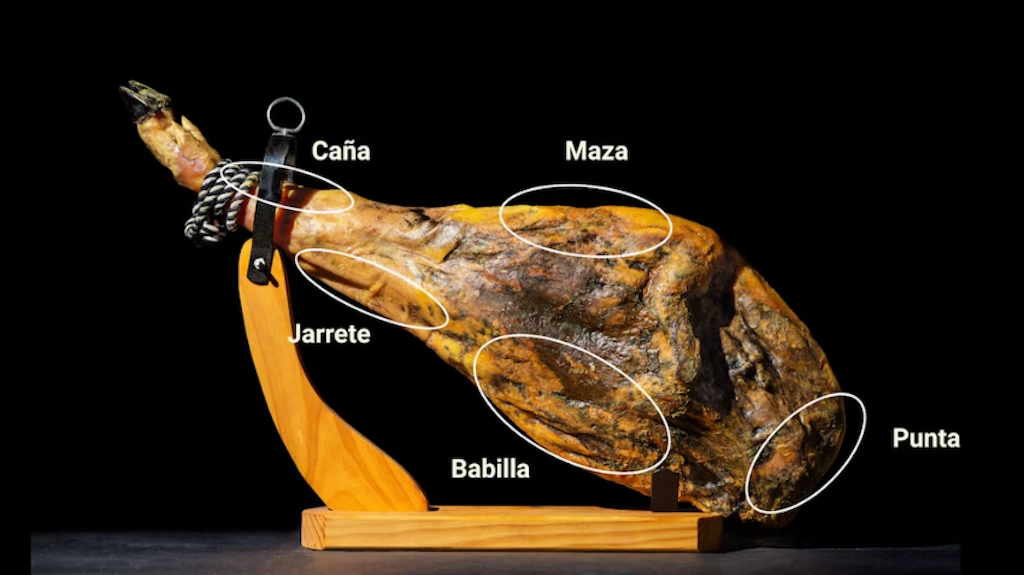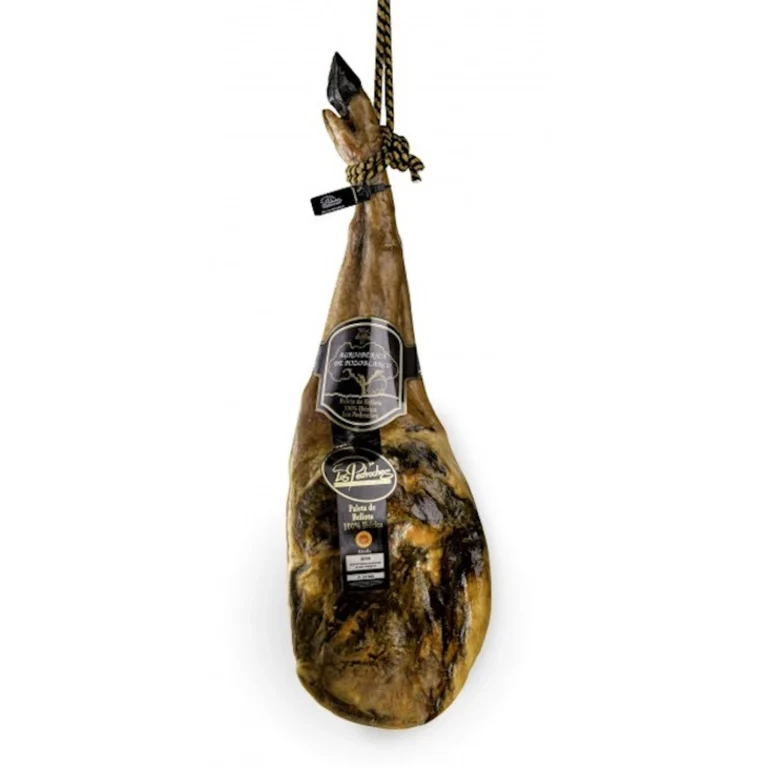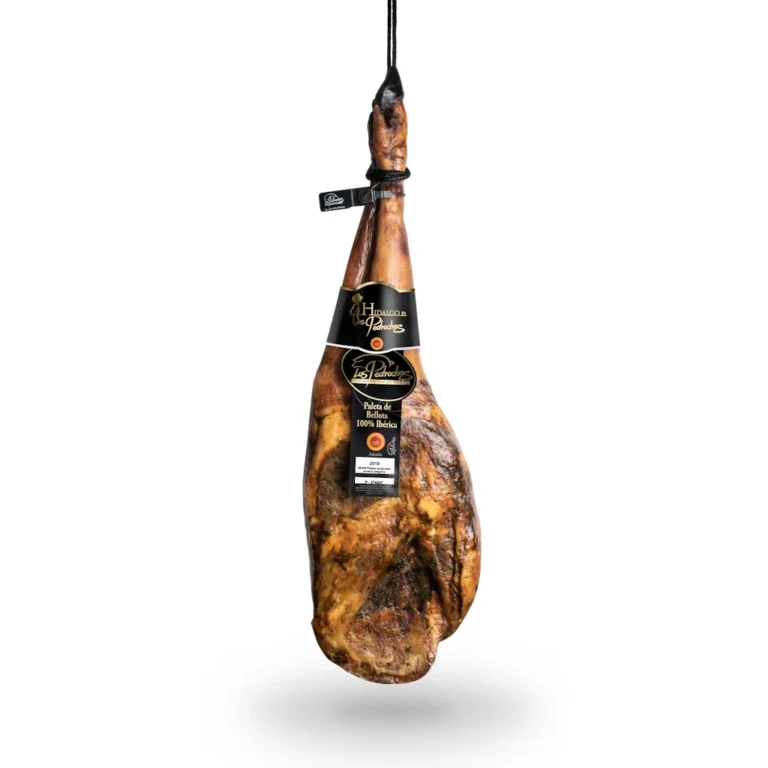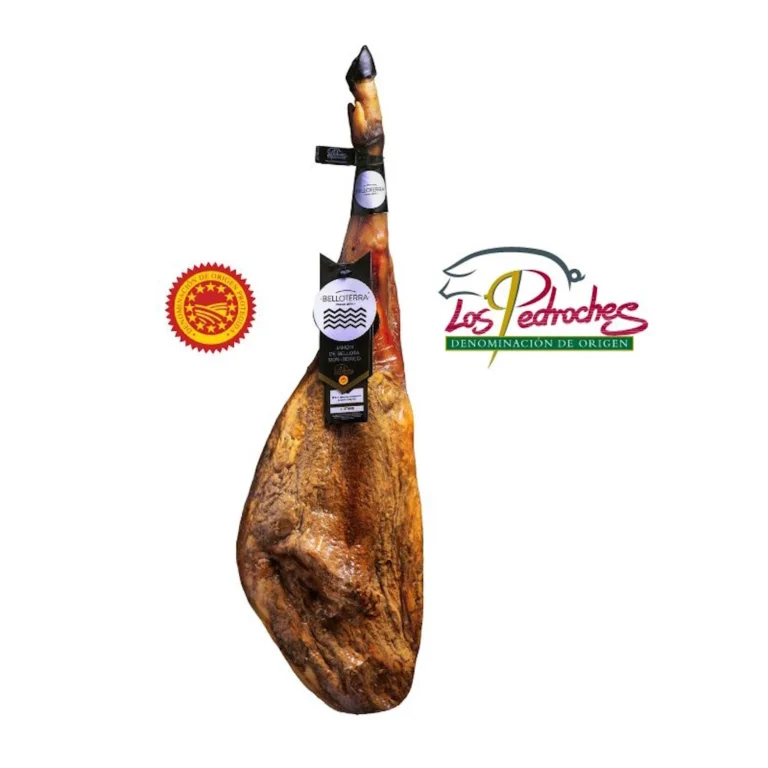Parts of a leg of Iberian ham
- Aroma and Flavor, DO Origin
Indice

Technical Anatomy and Organoleptic Profile of Iberian Ham
The study of the parts of an Iberian ham leg is fundamentally an analysis of its muscular anatomy and the resulting variation in fat distribution, factors that determine the organoleptic profile (flavor, aroma, texture) of each section. A piece of Iberian ham is a complex system where quality is segmented according to the pig’s biomechanics and the curing gradient.
The leg is divided into three main anatomical and, by extension, commercial regions:
Maza (Butt or Principal)
This is the widest and meatiest area, corresponding to the Biceps Femoris and Semimembranosus muscles. It is oriented towards the top and opposite the hip bone. It has the highest concentration of infiltrated and intermuscular fat. This fat, rich in oleic acid (up to 55%), melts at low temperatures, resulting in intense marbling. Intense, sweet, and persistent. It’s where the deepest flavors are found, due to the longer curing time and the higher proportion of acorn fat, which facilitates the formation of aromatic esters and aldehydes. Very juicy, soft, and melting. The fatty infiltration gives it the characteristic sensation of friability (easily crumbling in the mouth). High and complex aroma. This is the area of greatest aromatic intensity. It is the largest part, so its slicing performance is superior, maintaining quality for longer once the ham is opened.
Contramaza (Babilla)
Located on the opposite side of the Maca, next to the hip bone (ischium). Corresponds to the Vastus Lateralis and Rectus Femoris muscles. It has less intramuscular fat compared to the Mace, and less external fat coverage. The muscles are longer and more compact. Less intense and saltier. The thinner muscle and fat thickness facilitates greater and faster salt penetration during salting, although the curing process is equally prolonged. Firmer, less juicy, and more resistant to chewing. The lack of prominent marbling makes the meat leaner. Less complex, cleaner, and more direct. It is ideal for starting the cut, as it allows for slower consumption without the more valuable Mace drying out prematurely.
Tip (Hip or Elbow)
The end of the piece (opposite the hoof), near the pelvic bone. This is an area of great muscle convergence. Extremely high concentration of superficial fat and also excellent infiltration into the muscles near the hip. Extremely powerful and flavorful. A longer curing time and a more controlled level of salinity are common, resulting in a rich and pronounced flavor. A very mellow and creamy texture, the high proportion of dissolved fat in the muscle makes it extraordinarily smooth. Concentrated aroma with more evolved nuances due to the convergence of fats and the morphology of the piece.
Secondary and Transitional Zones
- Jarrete: Muscular section close to the hoof, made up mainly of flexor muscles and tendons. Its meat is fibrous and tough, but very aromatic due to its proximity to the bone and more intense curing. It is ideal for tacos or snacks.
- Codillo (Shank): The part that joins the Jaw with the Maca. It is highly prized for its high covering fat content and intense infiltration. It offers a flavor somewhere between the Maza and the Jarrete, with a very fibrous texture that becomes mellow when the fat melts.
- Bone/Marrow: The bone, especially the femur and hip (coxal), contributes to maturation. The bone marrow (marrow), rich in lipids, contributes additional volatile compounds to the surrounding muscle, intensifying the final aroma.
Organoleptic summary of the parts of an Iberian ham leg
The Iberian ham leg presents an organoleptic gradient that goes from the juiciest and sweetest (Maza) to the most intense and cured (Punta and Jarrete). The muscle-to-infiltrated fat ratio (which should be higher in Maza and Punta) and the dehydration kinetics (faster in Contramaza) are the technical factors that explain these differences. The art of the master ham maker lies in managing the curing process so that this spectrum of flavors reaches its full potential. The DOP, by requiring long minimum curing, ensures that even the leanest areas develop a sufficient aromatic profile.
Nota importante: aceitedelcampo.com promueve el consumo del aceite de oliva virgen extra por sus cualidades culinarias y beneficios para la salud. No obstante, no debe sustituirse ningún medicamento o tratamiento actual sin la orientación de un profesional de la salud.
Productos que te pueden interesar
16,50 € – 320,00 €Price range: 16,50 € through 320,00 €
140,00 € – 156,00 €Price range: 140,00 € through 156,00 €
18,50 € – 470,00 €Price range: 18,50 € through 470,00 €



